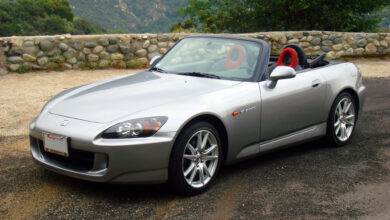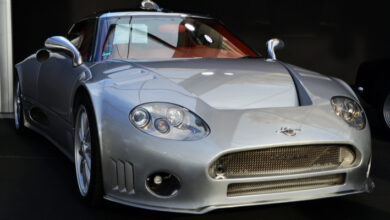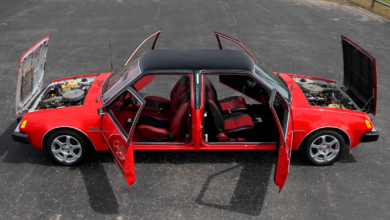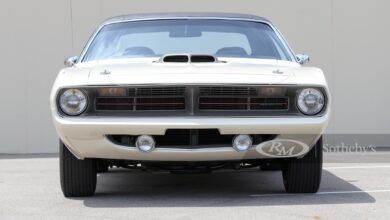Stop Throwing Away Money on New Cars and GO CLASSIC!
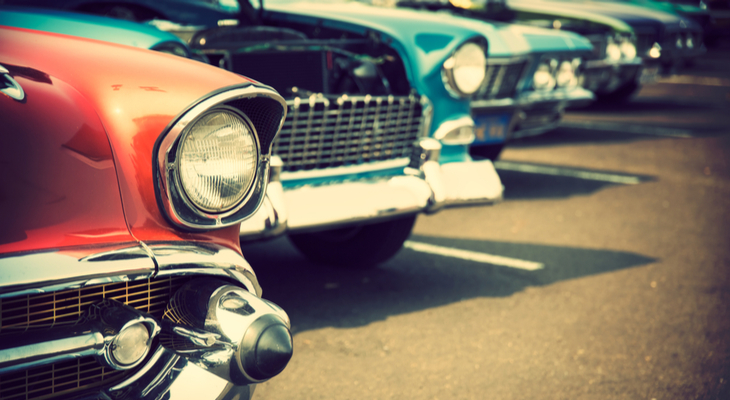
This is the first official episode of Tire Kickers, and in this episode I’m going to talk about building a classic car collection.
I made a decision about a year ago that I sort of had two options. I was frustrated with having depreciation on new cars, I was feeling guilty that after a couple of years of having a new car I wanted to trade it in, but I was losing so much money due to depreciation.
And I thought to myself, what if instead of making monthly payments on a new car I made monthly payments on a classic car, and then when those payments are done, I don’t have a car that’s worth 80% less than what it was worth when I bought it a few years ago, I have something that I can actually keep and do that every few years and start building out a classic car collection.
And so this 1961 Volkswagen bus was actually the second one that I added to the collection. It is probably my favorite one to drive on a daily basis. I love this car.
And so in this episode I’m going to talk a little bit about the decision-making process of building that classic car collection, the moment where I decided that I wasn’t going to buy brand new cars anymore, or try to buy them as little as possible.
And I hope you guys enjoy it. So we’re going to jump right in here with the first episode of Tire Kickers, and if you are not already subscribed to the channel, make sure you hit that subscribe button and comment below if you have any questions or comments.
All right, well this is an episode about building a classic car collection, which is kind of interesting because a few years ago I was all into buying new cars.
And one of the things that I found really frustrating was that I would buy a new car and a few years later when I was ready to trade it in, it would be worth half what I paid for it new. And it felt like man, well at this point I’ve already lost half of my money, or maybe three quarters of my money at this point, I might as well just keep driving it.
And I got into this habit of feeling so guilty trading in a used car for a new car because of the just economic loss that happens every single time you do that. And I did that few times before finally I was like you know what, this is enough, I’m getting frustrated.
And what finally did it in for me was actually Mercedes. Because I had a new Mercedes, and then I saw the new year’s model, even though the model that I had was a brand new model for that year and it was a brand new release, that the next year was going to have a substantial change to the headlights and the taillights.
And I was like, God dang it. This is a brand new car and now already it looks outdated, it looks used. And I wanted to go trade it in and it was already worth 30% less than what I had paid for it less than six and a half months earlier. And that’s when I was like, you know what, I’m done buying new cars, I’m going to start buying old cars.
And so the first old car that I bought, you can see behind me, is a 1969 Ford Mustang. And so the decision to buy a classic car, for me was kind of an economic decision.
I knew that I would need a new car that would be my daily drive or one that I could trust for long road trips and things like that, but for around town, for Sunday, and kind of just for that second car, I felt like maybe I didn’t need to have a brand new car.
Maybe I could get by with something that was a little older, a little bit more fun, and maybe has already depreciated in value and is now starting to appreciate. And so the decision of which classic car should you pick or did I pick, I mean, that’s going to be directed in a large part based just on your personal taste, what you like.
Now, I’ve actually never been a big, big fan of Mustangs, but what I decided to do was I put it out as a poll among all of the subscribers on my main YouTube channel, Warrior Trading, which at the time had about half a million subscribers.
And I said, “Okay guys, I’m thinking about getting a classic car.” I put down a couple of questions. I said, “Should I get a 21 or 23 window Volkswagen bus?” Which at the time I was like, “That would be a really fun car. Should I get Ford Mustang?”
Or I might have said just classic American muscle car. I don’t remember if I actually said Mustang or Camaro, and I think another option was like European classic car, sports car, like a Porsche, or like a Ferrari or something like that.
And I stipulate it, I’m not talking about new cars, I’m talking about old cars. And classic American muscle was like far and away the winner.
And so that kind of began my search because I was sort of open to whatever, and because I make a lot of content for YouTube and stuff like that, Facebook, I want to make sure that whatever I pick people like, and it’s going to be fun and, you know, be successful is part of content on this channel.
And so as I started getting into Mustangs, I was like, “All right, I really like the ’67, ’68, ’69 kind of era.” I like the fast back. I really liked the look of it, and at the time the Bullitt Mustang was going up for auction and the original one from the movie, I think it sold for like $3 million or something. So I was like, “Okay, Mustangs are hot right now.”
And then we’ve got the Ford versus Ferrari movie. And so Cobras and Shelby’s are kind of hot right now also. So I was like, “All right, I’m going to jump on this bandwagon.” And so the process for me though was I want to find a car that is a classic car, but I also want to make sure that it’s one that I think will increase in value.
So what does a car need to have in order to increase in value? So this is kind of part of the hunt for the first really good classic car for this garage right here.
And one of the reasons that I hadn’t bought a classic car sooner was because I didn’t have this space, but when this building, this whole building, it’s like 15, 20,000 square feet, when it came up for sale, it’s an old firehouse. I saw it and I was like, “This is going to be perfect.” I can use this building, the whole first floor, I’m going to start building a classic car collection, a classic car museum, the Tire Kickers museum gallery.
And some cars I’ll buy and sell and some I’ll hold. And some I want to actually be able to make available for rentals, for like film and video and commercials and stuff like that, photography, weddings, whatever.
So the goal here of trying to sort of break the ice with the first purchase, I was like, “All right, if I’m going to go for a Mustang, it’s got to have a couple of things. It’s got to be original color, it’s got to be engine number matching.”
So the VIN and the engine have to be the match from what came from the factory. I don’t want to get a Mustang that’s a resto mod. I don’t want to get one that’s been heavily modified, because that’s not going to be appealing to collectors 15, 20 years from now.
I want something that’s almost like a time capsule. And I want one that is a little bit rare. So in the world of Porsche, or Porsche, those would be racing cars, usually racing spec cars, the limited production that they released just to meet the, it’s like a homogenization type of standard for using that engine in competition.
And so Porsche 1973 RS, 911 RS, that one would be an awesome one to add to the collection. It’s got a steep price tag on it though, so that one I’m not ready for just yet. The 911, 993 RS or GT2, those would be great, very limited production that will almost always have a high demand in the collector market.
But with Mustang, it’s a little bit different, and so what I ended up going with is the 429. This is the NASCAR spec Mustang, it was sold in 1969, 857 were sold. And this is car, I believe 117, maybe 116. I can’t remember off the top of my head, but right around there.
It has an S code engine. It’s one of the early engines, the first 200 or so produced, had that S code engine, and so this is actually a very collectible car and it’s also a pretty fun car to drive, and it sounds absolutely incredible.
So that was the one for me where I broke the ice. But when it first arrived, I bought it sight unseen. It’s a little risky, but I had someone inspect it, pre-purchase inspection, and it had certificate of authenticity, you know, all that stuff you want to see.
Matching, VIN report, there’s a martini … I think that’s how you pronounce it, or martini whatever, report that comes with Shelby’s and Mustang. So I had all that stuff. It got out here. Now, when it shipped out here, it was, I want to say early March, and so it was cold and opened the garage doors, got it in here and I tried to, well so … it was hard to get it started on the trailer, it came in an enclosed trailer. It was hard to get started on the trailer, rolled it off the trailer, got it up here, we pushed it in here. And we realized it was out of gas.
So it was like, “All right, I’ll get some premium gas, top it off.” But I had a really hard time starting it. And I realized that this car having a choke and being just of the vintage that it is, is actually can be very difficult to start.
Now, some of that, you know, it probably wasn’t as hard to start in 1969, but you know, some of the components have worn and it’s an original engine, it’s all original though it’s been rebuilt, it still has some of those characteristics of a 50 year old car. So that was the car that I broke the ice on. And if I’m going to be honest, the first time I started it felt like the first time I started a chainsaw.
For anyone who’s used a chain saw, the first time you start a chain saw is a little scary. You know, you’ve cut your earmuffs on hopefully, and you’re just like, this thing can do some serious damage, and it’s loud and it’s rough. And it’s like a little adrenaline. And that’s how I felt when I started that car. And when I started driving it around, I felt myself very uncomfortable with it initially.
It’s got such a big engine and because I’d had a hard time starting it, I was afraid of stalling out. And so I was kind of always using a lot of gas coming out of first and from stops and stuff like that. And it’s got power steering, but it’s kind of like a little loose, you know, 1969, the brakes are tight. They’re good, but the transmission itself is kind of like, it doesn’t have a lot of feedback.
So after I got that one and drove it around a little bit, I sort of felt like I wanted something maybe a little bit different. And so the second car that I ended up buying was the 1961 Volkswagen Bus. I went for it. And I’ll say that I drive that car more than any of the others that I have.
The transmission is super easy, gas, brake, clutch, it’s all so easy to drive. It’s fun. Anytime you’re driving around, people are waving. They’re like, “Oh, check out that car.” It’s a red, 1961 Volkswagen Bus. And it’s just got a totally different vibe to it. And so that process of kind of finding the car for you, what’s interesting about it is that these different cars attract different people. There’s different people that come up to me in 1961 Volkswagen bus than who come up to me in a 1969 Ford Mustang Boss 429.
And if you’re the type of person that wants to go to the car rallies or the car shows, things like that, cars and coffee, those types of events, you kind of have to think about what’s your crowd? You know, what kind of car do you like and do you like the other people that like that car? It’s sort of a whole culture fit around these different market segments.
American muscle cars, European classics, but even within those, you know, Porsche, Volkswagen, Ferrari, they all have like a little bit of a different feel. So one of the goals, and one of the challenges I would say with buying old cars, is that it’s not always feasible to test drive them before you buy them, depending on where you are.
If you’re looking for something very specific, you know, a 1969 Ford Mustang, there’s 857 ever built. So at any time for sale, there might only be one or two. And you know, it might be halfway across the country. So you can do pre-purchase inspections and things like that, but actually getting out there and having those folks let you get in the driver’s seat of that type of car and drive it around, it may not happen.
So part of gaining experience as a collector and as an enthusiast, is pulling a trigger and buying some but knowing that unlike buying a brand new car, you’re not going to suffer depreciation the second you get it off the lot or into your garage.
This is something that you could turn around and sell, each one of these, you could list it for the same amount of money that I paid for it. And there’s going to be someone lined up that’s going to be wanting to pick it up. Because the market value, I mean, you know, the market value fluctuates certainly from year to year, but generally speaking, these are a very limited commodity, and that’s important when you’re building your collection.
You wouldn’t want to buy a brand new Ferrari 488 for a collection. It’s brand new, it’s mass produced. Even by Ferrari standards that’s the limited number, but it’s not 458’s. You know, these are not highly collectible cars, not yet, and they won’t be for awhile.
And so one of the things I want to be able to do here in this space is put together this collection of classic cars. Some of them classic American, some of them European.
I really like the Volkswagen, I really like this Porsche, and some of the newer ones are okay too, and give people an opportunity to actually enjoy them. I think one of the things that really is unfortunate is that a lot of these cars end up getting put away in collections in garages and no one gets to see them.
And so my goal is to be able to open these doors up and let people come in and check them out and walk around them and, you know, kick the tires so to speak, and see, “Is this the car that I like? Is this something that I would want to drive someday or own?”, or whatever the case is. So the process of building the collection, maybe for me, is different from others. But I would say if I was only going to have one car, it probably wouldn’t be the 429, but there might be a Ford, there might be a Ford or a Shelby in there because they sound so mean.
All right, so I hope this has been interesting for you. This is again, kind of me just talking out my thought process as I’ve been building this collection, which as I look back on this video maybe three years or five years from now, it’ll be cool for me to kind of go back and see like where this all began.
So this building right here, this is kind of the beginning. I’ve got these three cars right here on this side right now, but we’re just going to be starting construction on this whole building. So it can actually be a really nice space, not only for the work I do with day trading and hosting seminars and events, but also for the Tire Kicker gallery and rental space and show room space.
So we’ve got all this space here. I’ll be able to have cars lined up over there. Right here, probably have a couple on either side here. All of this is also going to be multipurpose space, which is kind of important. I would say that another component to my decision-making is the fact that the US equities market has been so crazy. Look at this. The US equities market has been so crazy this year, I haven’t felt super comfortable dumping a lot of money into the market.
You know, I mean the market has been insane. Now, I’m happy to day trade it, but in terms of investing in the market, it feels priced too high right now. And so that kind of made me feel like, you know, the nice thing about some of these cars is that I can, you know, this is a 993 Porsche key chain, with these cars I can park money in them. I can enjoy them, and a lot of them. There’s a good chance that I’ll be able to sell them for more money than I paid for them.
I’m not trying to get rich buying and selling cars, but as the market changes, you know, not unlike a flip, you know, when you buy it, clean it up and sell it. When the market appreciates and the value of the car goes up, you have an opportunity to sell it at current market price. Right? And so that’s kind of the idea that, you know, you can’t really, I mean, you could pass stock certificates of Apple or IBM onto your children, but are you going to form memories?
Enjoying washing those stock certificates and, you know, bringing those stock certificates and your kids with them to, you know, a soccer game? I don’t think you will. And so the nice thing with the car, the classic car collections, that classic cars while probably is maybe even less risky an investment as the stock market, maybe an investment, but one that’s somewhat risky, but one that has a better chance of holding value. And at the very least you get enjoyment out of.
And that’s something that, you know, when you park money in the market, I feel that vulnerability, I like to have something tangible.
And so that’s kind of a, almost contradiction in me as like a full-time day trader, but then taking money out of the market and not really wanting to reinvest all of it back into the same market where I got it, especially at the current prices.
And again, two years from now, three years from now in the market, maybe is a little bit different, I might feel differently about that, but it’s sort of part of the current market environment that this year we saw the market drop 30%, rebound all the way up and which is crazy, and then drop another 10, 15% off those levels.
I mean, this is kind of insane. So right now I’ve stepped aside, I’m starting to build a little bit of a car collection working on the Tire Kickers project here, and I hope you guys will join me on the journey. All right, I’ll see you guys for the next episode.
